电气工程及其自动化专业英语 Chapter 1 Fundamentals of Electric Circuits
电气工程与自动化专业英语第一章课文翻译
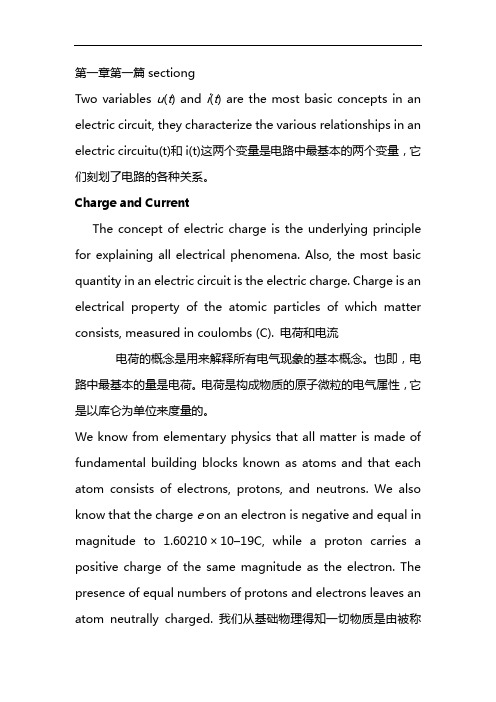
第一章第一篇sectiongTwo variables u(t) and i(t) are the most basic concepts in an electric circuit, they characterize the various relationships in an electric circuitu(t)和i(t)这两个变量是电路中最基本的两个变量,它们刻划了电路的各种关系。
Charge and CurrentThe concept of electric charge is the underlying principle for explaining all electrical phenomena. Also, the most basic quantity in an electric circuit is the electric charge. Charge is an electrical property of the atomic particles of which matter consists, measured in coulombs (C). 电荷和电流电荷的概念是用来解释所有电气现象的基本概念。
也即,电路中最基本的量是电荷。
电荷是构成物质的原子微粒的电气属性,它是以库仑为单位来度量的。
We know from elementary physics that all matter is made of fundamental building blocks known as atoms and that each atom consists of electrons, protons, and neutrons. We also know that the charge e on an electron is negative and equal in magnitude to 1.60210×10 19C, while a proton carries a positive charge of the same magnitude as the electron. The presence of equal numbers of protons and electrons leaves an atom neutrally charged. 我们从基础物理得知一切物质是由被称为原子的基本构造部分组成的,并且每个原子是由电子,质子和中子组成的。
电气工程及其自动化专业英语第一章课文翻译
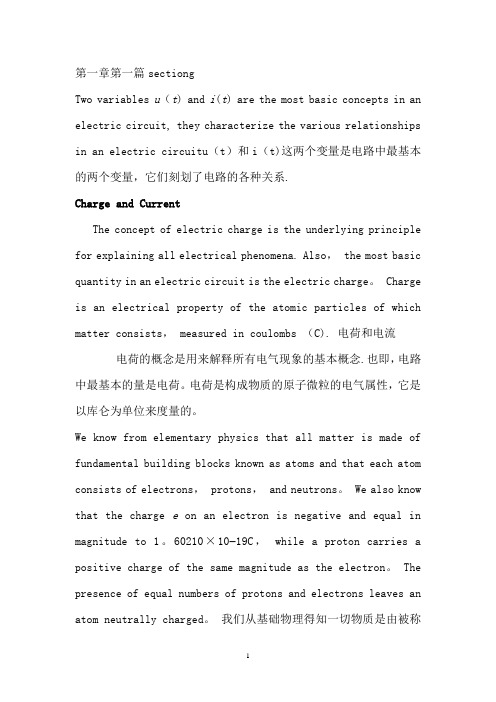
第一章第一篇sectiongTwo variables u(t) and i(t) are the most basic concepts in an electric circuit, they characterize the various relationships in an electric circuitu(t)和i(t)这两个变量是电路中最基本的两个变量,它们刻划了电路的各种关系.Charge and CurrentThe concept of electric charge is the underlying principle for explaining all electrical phenomena. Also, the most basic quantity in an electric circuit is the electric charge。
Charge is an electrical property of the atomic particles of which matter consists, measured in coulombs (C). 电荷和电流电荷的概念是用来解释所有电气现象的基本概念.也即,电路中最基本的量是电荷。
电荷是构成物质的原子微粒的电气属性,它是以库仑为单位来度量的。
We know from elementary physics that all matter is made of fundamental building blocks known as atoms and that each atom consists of electrons, protons, and neutrons。
We also know that the charge e on an electron is negative and equal in magnitude to 1。
专业英语翻译第一章
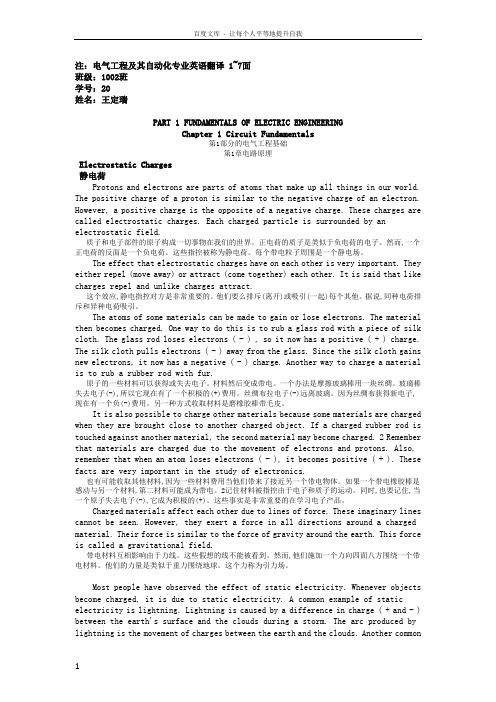
注:电气工程及其自动化专业英语翻译 1~7面班级:1002班学号:20姓名:王定瑞PART 1 FUNDAMENTALS OF ELECTRIC ENGINEERINGChapter 1 Circuit Fundamentals第1部分的电气工程基础第1章电路原理Electrostatic Charges静电荷Protons and electrons are parts of atoms that make up all things in our world. The positive charge of a proton is similar to the negative charge of an electron. However, a positive charge is the opposite of a negative charge. These charges are called electrostatic charges. Each charged particle is surrounded by an electrostatic field.质子和电子部件的原子构成一切事物在我们的世界。
正电荷的质子是类似于负电荷的电子。
然而,一个正电荷的反面是一个负电荷。
这些指控被称为静电荷。
每个带电粒子周围是一个静电场。
The effect that electrostatic charges have on each other is very important. They either repel (move away) or attract (come together) each other. It is said that like charges repel and unlike charges attract.这个效应,静电指控对方是非常重要的。
他们要么排斥(离开)或吸引(一起)每个其他。
电气工程及其自动化专业 外文文献 英文文献 外文翻译 plc方面
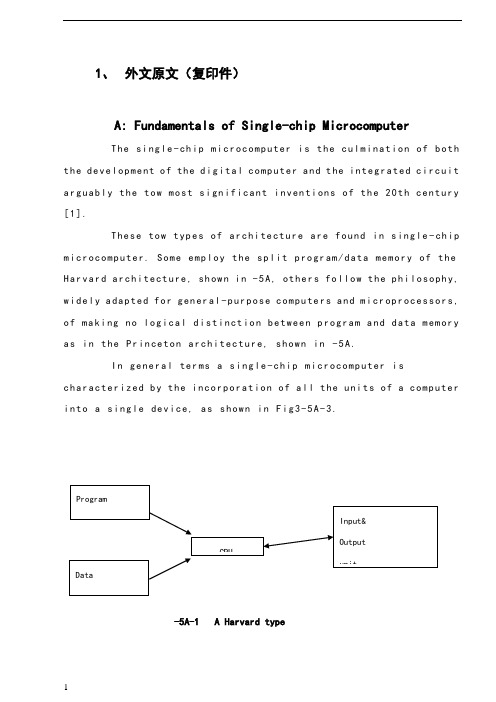
1、外文原文(复印件)A: Fundamentals of Single-chip MicrocomputerTh e si ng le-ch i p mi cr oc om pu ter is t he c ul mi nat i on o f bo th t h e d ev el op me nt o f th e d ig it al com p ut er an d t he int e gr at ed ci rc ui ta r gu ab ly th e t ow m os t s i gn if ic ant i nv en ti on s o f t h e 20t h c en tu ry[1].Th es e to w typ e s of a rc hi te ctu r e ar e fo un d i n s in gl e-ch ip m i cr oc om pu te r. So m e em pl oy t he sp l it p ro gr am/d ata me mo ry o f th e H a rv ar d ar ch it ect u re, sh ow n i n -5A, ot he rs fo ll ow th e ph i lo so ph y, w i de ly a da pt ed fo r g en er al-p ur pos e c om pu te rs an d m i cr op ro ce ss or s, o f m a ki ng no lo gi c al di st in ct io n b e tw ee n p ro gr am a n d da t a m em ory a s i n th e Pr in cet o n ar ch it ec tu re,sh ow n in-5A.In g en er al te r ms a s in gl e-chi p m ic ro co mp ut er i sc h ar ac te ri zed b y the i nc or po ra tio n of al l t he uni t s o f a co mp ut er i n to a s in gl e dev i ce, as s ho wn in Fi g3-5A-3.-5A-1 A Harvard type-5A. A conventional Princeton computerFig3-5A-3. Principal features of a microcomputerRead only memory (ROM).R OM i s u su al ly f or th e p er ma ne nt, n o n-vo la ti le s tor a ge o f an a pp lic a ti on s pr og ra m .M an ym i cr oc om pu te rs an d mi cr oc on tr ol le r s a re in t en de d fo r h ig h-v ol ume a p pl ic at io ns a nd h en ce t he e co nom i ca l ma nu fa ct ure of t he d ev ic es r e qu ir es t ha t the co nt en ts o f the pr og ra m me mo ry b e co mm it te dp e rm an en tl y d ur in g th e m an uf ac tu re o f c hi ps . Cl ear l y, th is im pl ie sa ri g or ou s a pp roa c h t o R OM co de d e ve lo pm en t s in ce c ha ng es ca nn otb e m ad e af te r man u fa ct ur e .T hi s d e ve lo pm en t pr oce s s ma y in vo lv e e m ul at io n us in g a s op hi st ic at ed deve lo pm en t sy st em w i th a ha rd wa re e m ul at io n ca pa bil i ty a s we ll a s th e u se of po we rf ul so ft wa re t oo ls.So me m an uf act u re rs p ro vi de ad d it io na l RO M opt i on s byi n cl ud in g i n th ei r ra ng e de vi ce s wi th (or i nt en de d fo r us e wi th) u s er pr og ra mm ab le m em or y. Th e s im p le st of th es e i s us ua ll y d ev ice w h ic h ca n op er ate in a m ic ro pr oce s so r mo de b y usi n g so me o f th e i n pu t/ou tp ut li ne s as a n ad dr es s an d da ta b us f or acc e ss in g e xt er na l m e mo ry. T hi s t ype o f d ev ic e c an b e ha ve fu nc ti on al l y a s t he si ng le c h ip mi cr oc om pu te r fr om wh ic h i t i s de ri ve d a lb eit w it h r es tr ic ted I/O an d a mo di fie d e xt er na l ci rcu i t. T he u se o f t h es e RO Ml es sd e vi ce s is c om mo n e ve n in p ro du ct io n c ir cu it s wh er e t he v ol um e do es n o t ju st if y th e d e ve lo pm en t co sts of c us to m on-ch i p RO M[2];t he re c a n st il l b e a si g ni fi ca nt s a vi ng in I/O a nd ot he r c hi ps co mp ar ed t o a c on ve nt io nal mi cr op ro ce ss or b as ed c ir cu it. M o re e xa ctr e pl ac em en t fo r RO M d ev ic es c an b e o bt ai ne d in t he f o rm o f va ri an ts w i th 'pi gg y-ba ck'EP RO M(Er as ab le p ro gr am ma bl e ROM)s oc ke ts o rd e vi ce s w it h EP ROM i ns te ad o f R OM 。
电气工程及其自动化专业英语学习简介

2024年6月20日
page12
2.1.2 广泛使用非谓语形式
1)动名词(gerund) ➢用动名词短语取代时间从句或简化时间陈述句
gerund phrase→ time subordinate clause ➢用动名词短语做主语 gerund phrase → subject 2)分词(participle) 过去分词短语替代被动语态Past Participle→Passive voice 现在分词短语替代主动语态Present Participle→ Active voice; 3)不定式(infinitive) 用不定式短语来替代表示目的和功能的从句或语句
cannot …too(over) You can’t be too careful. ➢ A circuit breaker operation is followed by a disconnector operation.
断路器操作要被隔离开关操作跟随。 断路器操作后要进行隔离开关操作。
2024年6月20日
system.
If possible, the open-loop control approach should be used in this system. 可能的话,这个系统应该使用开环控制方法。 2) As illustrated in Fig.1, there is a feedback element in the closed-loop
system.
As in Fig.1, there is a feedback element in the closed-loop system. 就像图1所示的那样,这个闭环系统中有一个反馈元件。
2024年6月20日
电气工程及其自动化专业外文文献英文文献外文翻译方面
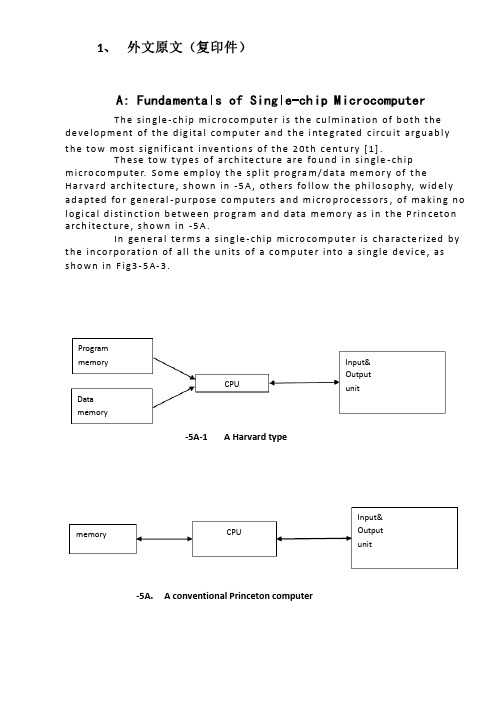
1、 外文原文(复印件)A: Fundamentals of Single-chip MicrocomputerT h e sin gle -ch ip mi c ro co m p u t e r is t h e cu lm in at io n of b ot h t h e d e ve lo p me nt of t h e d ig ita l co m p u t e r a n d t h e i nte g rated c ircu it a rgu ab l y t h e to w mo st s ign if i cant i nve nt i o n s of t h e 20t h c e nt u ry [1].T h ese to w t yp e s of arch ite ct u re are fo u n d in s in gle -ch ip m i cro co m p u te r. S o m e e mp l oy t h e sp l it p ro gra m /d at a m e m o r y of t h e H a r va rd arch ite ct u re , s h o wn in -5A , ot h e rs fo l lo w t h e p h i lo so p hy, wid e l y ad a p ted fo r ge n e ral -p u rp o se co m p u te rs an d m i cro p ro ce ss o rs , of m a kin g n o l o g i ca l d i st in ct i o n b et we e n p ro gra m an d d ata m e m o r y as in t h e P rin c eto n a rch ite ct u re , sh o wn in -5A.In ge n e ra l te r m s a s in g le -ch ip m ic ro co m p u t e r is ch a ra cte r ized b y t h e in co r p o rat io n of all t h e u n its of a co mp u te r into a s in gle d e vi ce , as s h o w n in F i g3-5A-3.-5A-1A Harvard type-5A. A conventional Princeton computerProgrammemory Datamemory CPU Input& Output unitmemoryCPU Input& Output unitResetInterruptsPowerFig3-5A-3. Principal features of a microcomputerRead only memory (ROM).RO M is u su a l l y fo r t h e p e r m an e nt , n o n -vo lat i le sto rage of an ap p l i cat io n s p ro g ram .M a ny m i c ro co m p u te rs a n d m i cro co nt ro l le rs are inte n d ed fo r h i gh -vo lu m e ap p l i cat io n s a n d h e n ce t h e e co n o m i cal man u fa c t u re of t h e d e vi ces re q u ires t h at t h e co nt e nts of t h e p ro gra m me mo r y b e co mm i ed p e r m a n e nt l y d u r in g t h e m a n u fa ct u re of c h ip s . C lea rl y, t h i s imp l ies a r i go ro u s ap p ro a ch to ROM co d e d e ve lo p m e nt s in ce ch an ges can n o t b e mad e af te r m an u fa ct u re .T h i s d e ve l o p m e nt p ro ces s m ay i nvo l ve e mu l at i o n u sin g a so p h ist icated d e ve lo p m e nt syste m wit h a h ard wa re e mu l at i o n capab i l it y as we ll as t h e u s e of p o we rf u l sof t war e to o l s.So m e m an u fa ct u re rs p ro vi d e ad d it i o n a l ROM o p t io n s b y in clu d in g in t h e i r ran ge d e v ic es w it h (o r inte n d ed fo r u s e wit h ) u se r p ro g ram m a b le m e mo r y. T h e s im p lest of t h e se i s u su a l l y d e v i ce wh i ch can o p e rat e in a m i cro p ro ce s so r mo d e b y u s in g s o m e of t h e in p u t /o u t p u t l in es as an ad d res s a n d d ata b u s fo r a cc es sin g exte rn a l m e m o r y. T h is t yp e o f d e vi ce can b e h ave f u n ct i o n al l y as t h e s in gle ch ip m i cro co m p u t e r f ro m wh i ch it i s d e ri ved a lb e it wit h re st r icted I/O an d a m o d if ied exte rn a l c ircu it. T h e u s e of t h e se RO M le ss d e vi ces i s co mmo n e ve n in p ro d u ct io n circu i ts wh e re t h e vo lu m e d o e s n ot ju st if y t h e d e ve lo p m e nt co sts of cu sto m o n -ch ip ROM [2];t h e re ca n st i ll b e a si gn if i cant sav in g in I/O an d o t h e r ch ip s co m pared to a External Timing components System clock Timer/ Counter Serial I/O Prarallel I/O RAM ROMCPUco nve nt io n al m i c ro p ro ces so r b ased circ u it. M o re exa ct re p l a ce m e nt fo rRO M d e v ice s can b e o b tain ed in t h e fo rm of va ria nts w it h 'p i g g y-b a c k'E P ROM(E rasab le p ro gramm ab le ROM )s o cket s o r d e v ice s w it h E P ROMin stead of ROM 。
Chapter 1 Fundamentals of Electric Circuits section 1-4 Kirchhoff’s Laws 电气工程及其自动化专业英

Exercises
III. Translate the following into Chinese
If a circuit has two or more independent sources, one way to determine the value of a specific variable (voltage or current) is to use nodal or mesh analysis. Another way is to determine the contribution of each independent source to the variable and then add them up. The latter approach is known as the superposition. The superposition principle states that the voltage across (or current through) an element in a linear circuit is the algebraic sum of the voltages across (or currents
(1-15)
Section4 Kirchhoff’s Laws
An alternative form of KCL: The sum of the currents entering a node is equal to the sum of the currents leaving the node.
Since current i1, i3, i4 are entering the node, while currents i2, and i5 are leaving it. By rearranging the Eq.(114), we get
电气工程及其自动化专业英语第一章第五节

电气工程及其自动化专业英语第一章第五节第一篇:电气工程及其自动化专业英语第一章第五节第五节基本分析方法在已经了解了电路理论的基本理论(欧姆定律和基尔荷夫定律)之后,我们准备应用这些定律导出电路分析的两个很有用的方法:节点分析法以及网孔分析法。
前者基于基尔荷夫电流定律(KCL)的有序应用,后者基于基尔荷夫电压定律(KVL)的有序应用。
根据这一节所导出的这两种方法,我们就能够通过列出一套有关方程然后求解所需的电压和电流来分析几乎任何电路。
求解联立方程的一种方法涉及克莱姆法则,这个法则使我们可以把电路变量当作行列式系数来计算。
节点分析法对于很多网络来说,选择节点电压(作为电路变量)是一个很方便的做法。
由于电压被定义为存在于两个节点之间的电压,所以我们可以方便地选择网络中的一个节点作为参考节点或基准节点,然后和其它节点的电压或电位差相联系。
每个非参考节点的电压相对于参考节点来说被定义为该节点电压。
通常的做法是选择极性时使节点的电压相对于参考节点为正。
对于一个包含有N个节点的电路而言,将会有N-1个节点电压,当然,如果存在电压源的话,他们中的一些可能是已知的。
我们通常选择那个连接有最多条支路的节点作为参考节点。
许多实际的电路是建立在金属底版或底盘上,并且通常有很多个元件连接到底盘上,然后这个底盘通常接地。
这个底盘于是就可以被称为地,并在逻辑上被选作参考节点。
由于这个原因,参考节点通常指地。
于是,参考节点的电位就是地电位或零电位,其它节点可以被认为是处于零电位之上的某个电位。
应用KCL我们将得到与节点电压有关的方程式。
显然,连接有很多元件的节点被选为参考节点时,将结果方程进行简化是可以做到的。
然而,我们应该知道,这并不是选择参考节点时的唯一标准,但它通常是最常用的标准。
在图1-15所示的网络中,存在有3个节点,数目如图所示。
由于有4条支路连接到节点3,所以我们把它选作参考节点,用所示的连地符号来标明。
节点1和节点3之间的电压表明为u1,而u2定义为节点2和参考节点之间的电压。
电气工程专业英语unt

A loop is said to be (可认为是)independent if it contains a branch which is not in any other loop.
The two circuits in Fig.1.1 and Fig.1.2 are identical.
However, for the sake of clarity②, nodes b and c are spread out ③with perfect conductors as in Fig.1.2.
Notice that the three points that form node b ① are connected by perfectly conducting wires and therefore constitute a single point.
Note:① "three points that form node b "表示"形成节点
Two or more elements are in series (串联)if they are cascaded or connected sequentially (接顺序连接)and consequently carry the same current(流过相同电流).
Two or more elements are in parallel (并联)if they are connected to the same two nodes and consequently
abca ,意为包含2Ω电阻的闭合路径abca。
电气工程专业英语+unt1参考文档

Unit 1 Fundamentals of Electronic Circuits
1.1 Introduction to Circuit Theory 1.2 Analog and Digital Circuits 1.3 Three-Phase Circuits 1.4 Further Reading
Notice that the three points that form node b ① are connected by perfectly conducting wires and therefore constitute a single point.
Note:① "three points that form node b "表示"形成节点
b的3个点".此句可译为:注意到形成节点b的3个点是通过理
elements or devices, whereas a circuit is a network
providing one or more closed paths③.
Note:②:regard … as表示“把…认为” NNoottee::③①::pdrioffveirtfherse为ntiate nbeettwwoerekn的A后an置d 定B表语示。区分A和B;To differentiate between a circuit and a network是目的状语从句.
series
n. 连续;系列;级数;串联
parallel
adj. 平行的;并联的 n. 平行线;平
行面;v. 相应;平行
impedance
n. [电]阻抗;全电阻;[物]阻抗
theorem
n. [数]定理;法则
电气工程及其自动化专业英语第一章课文翻译

第一章第一篇sectiongTwo variables u(t) and i(t) are the most basic concepts in an electric circuit, they characterize the various relationships in an electric circuitu(t)和i(t)这两个变量是电路中最基本的两个变量,它们刻划了电路的各种关系。
Charge and CurrentThe concept of electric charge is the underlying principle for explaining all electrical phenomena. Also, the most basic quantity in an electric circuit is the electric charge. Charge is an electrical property of the atomic particles of which matter consists, measured in coulombs (C). 电荷和电流电荷的概念是用来解释所有电气现象的基本概念。
也即,电路中最基本的量是电荷。
电荷是构成物质的原子微粒的电气属性,它是以库仑为单位来度量的。
We know from elementary physics that all matter is made of fundamental building blocks known as atoms and that each atom consists of electrons, protons, and neutrons. We also know that the charge e on an electron is negative and equal in magnitude to 1.60210×10 19C, while a proton carries a positive charge of the same magnitude as the electron. The presence of equal numbers of protons and electrons leaves an atom neutrally charged. 我们从基础物理得知一切物质是由被称为原子的基本构造部分组成的,并且每个原子是由电子,质子和中子组成的。
Chapter01电子课件

Chapter 1 Circuit Fundamentals [7]The power ratings of motors and generators is greater when three-phase ac power is used. For a certain frame size, the rating of a three-phase ac motor is almost 50% larger than a similar single-phase ac motor.
当使用三相交流电源时,电动机和发电机的功率额定值要比 单相的大得多。对某一结构尺寸的交流电动机,三相交流电 动机的功率额定值要比相似的单相交流电动机大约大50%。
Chapter 1 Circuit Fundamentals 5. 重点段落翻译 [1] 第2页第1段落 “Electrical charges are used to filter … … or positive charge.”
导体价电子层电子的运动产生电流。导体原子的外部电子叫 做自由电子,当这些电子运动时释放出能量,从而做功。
Chapter 1 Circuit Fundamentals [4]A circuit is a path or conductor for electric current flow. Electric current flows only when it has a complete, or closed-circuit, path. There must be a source of electrical energy to cause current to flow along a closed path.
Chapter 1 Fundamentals of Electric Circuits section 1-3 Ohm’s Law 电气工程及其自动化专业英语课

usually a connecting wire assumed to be a perfect
conductor. Thus, a short circuit is a circuit element
with resistance approaching zero.
Section3 Ohm’s Law
2. Ohm's Law states that the voltage across a resistor is the current flowing through the resistor.
A. equal to
B. directly proportional to
C. inversely proportional to D. different from
and voltage shown, Ohm's law is
uRi(t)
(1-9)
Fig.1-8 Circuit symbol for the resistor
Section3 Ohm’s Law
where R ≥0 is the resistance in ohms. Rearranging Eq. (1-9) into the form R = u(t) / i(t),
Fig.1-10
Typical
voltage-current
characteristic for a
nonlinear resistor
Section3 Ohm’s Law
In reality, all practical resistors are nonlinear because the electrical characteristics of all conductors are affected by environmental factors such as temperature. Many materials, however, closely approximate an ideal linear resistor over a desired operating region. We shall concentrate on these types of elements and simply refer to them as resistors.
电气工程及其自动化专业英语第一单元课件

equivalent circuit 等效电路 electronic circuit 电子线路,电子电路 digital circuit 数字电路 circuit diagram 电路图;线路图 closed circuit 闭合线路,闭合电路 drive circuit 驱动电路;激励电路 magnetic circuit 磁路 analog circuit 模拟电路;类比电路
电压和电流是电路里的两个基本概念,他们描述了电路中的 各种关系.
Section 1 Current and Voltage
We know from elementary physics that all matter is made of fundamental building blocks known as atoms and that each atom consists of electrons, protons, and neutrons.
电流方向和电压极性决定了功率符号。因此,需要关注图 (1-3)a中电压u与电流i的关系。
Grammar Features
语法特点
客观性(Objective)、准确性(accuracy)和精练 (conciseness)。
(1) 广泛使用被动语态
(2) 广泛使用非谓语形式 (3) 省略句使用频繁 (4) It句型和祈使句使用频繁 (5) 复杂长句使用频繁
power n. 功率;力量;能力;政权;势力;[数] 幂 vt. 激励;供以动力;使…有力量 vi. 快速前进 adj. 借影响有权势人物以操纵权力的 (physics) the rate of doing work; measured in watts (= joules/second)
电气工程及其自动化专业英语第一章课文翻译

第一章第一篇sectiongTwo variables u(t) and i(t) are the most basic concepts in an electric circuit, they characterize the various relationships in an electric circuitu(t)和i(t)这两个变量是电路中最基本的两个变量,它们刻划了电路的各种关系。
Charge and CurrentThe concept of electric charge is the underlying principle for explaining all electrical phenomena. Also, the most basic quantity in an electric circuit is the electric charge. Charge is an electrical property of the atomic particles of which matter consists, measured in coulombs (C). 电荷和电流电荷的概念是用来解释所有电气现象的基本概念。
也即,电路中最基本的量是电荷。
电荷是构成物质的原子微粒的电气属性,它是以库仑为单位来度量的。
We know from elementary physics that all matter is made of fundamental building blocks known as atoms and that each atom consists of electrons, protons, and neutrons. We also know that the charge e on an electron is negative and equal in magnitude to 1.60210×1019C, while a proton carries a positive charge of the same magnitude as the electron. The presence of equal numbers of protons and electrons leaves an atom neutrallycharged. 我们从基础物理得知一切物质是由被称为原子的基本构造部分组成的,并且每个原子是由电子,质子和中子组成的。
电气工程及其自动化专业英语第一章课文翻译

第一章第一篇sectiongTwo variables u(t) and i(t) are the most basic concepts in an electric circuit, they characterize the various relationships in an electric circuitu(t)和i(t)这两个变量是电路中最基本的两个变量,它们刻划了电路的各种关系。
Charge and CurrentThe concept of electric charge is the underlying principle for explaining all electrical phenomena. Also, the most basic quantity in an electric circuit is the electric charge. Charge is an electrical property of the atomic particles of which matter consists, measured in coulombs (C). 电荷和电流电荷的概念是用来解释所有电气现象的基本概念。
也即,电路中最基本的量是电荷。
电荷是构成物质的原子微粒的电气属性,它是以库仑为单位来度量的。
We know from elementary physics that all matter is made of fundamental building blocks known as atoms and that each atom consists of electrons, protons, and neutrons. We also know that the charge e on an electron is negative and equal in magnitude to ×1019C, while a proton carries a positive charge of the same magnitude as the electron. The presence of equal numbers of protons and electrons leaves an atom neutrally charged. 我们从基础物理得知一切物质是由被称为原子的基本构造部分组成的,并且每个原子是由电子,质子和中子组成的。
电气工程及其自动化专业英语第一章第一节
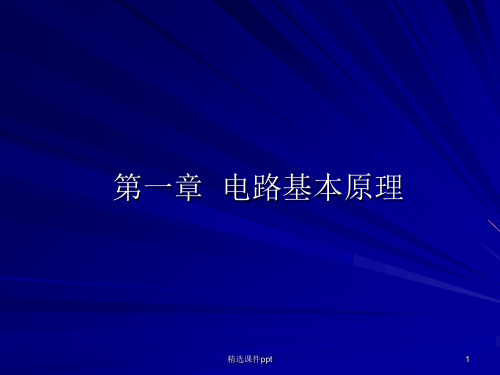
精选课件ppt
8
这种情况被称为无源符号惯例,对于无源符号惯 例来说,电流流进电压的正极。在这种情况下,p=ui 或ui>0,表明元件是在吸收功率。而如果p=-ui或 ui<0,如图1-3(b)所示时,表明元件是在释放或提 供功率。
当我们把一根导线连接到某一电池上时(一种电动 势源),电荷被外力驱使移动;正电荷朝一个方向移动 而负电荷朝相反的方向移动。这种电荷的移动产生了电 流。我们可以很方便地把电流看作是正电荷的移动,也 即,与负电荷的流动方向相反,如图1-1所示。这一 惯例是由美国科学家和发明家本杰明-富兰克林引入的。 虽然我们现在知道金属导体中的电流是由负电荷引起的, 但我们将遵循通用的惯例,即把电流看作是正电荷的单 纯的流动。于是电流就是电荷的时率,它是以安培为单 位来度量的。从数学上来说,电流i、电荷q以及时间t之 间的关系是:
第一章 电路基本原理
精选课件ppt
1
第一节 电流和电压
u(t)和i(t)这两个变量是电路中最基本的两个变量, 它们刻划了电路的各种关系。
电荷和电流 电荷的概念是用来解释所有电气现象的基本概念。
也即,电路中最基本的量是电荷。电荷是构成物质的 原子微粒的电气属性,它是以库仑为单位来度量的。
我们从基础物理得知一切物质是由被称为原子的
精选课件ppt
3
idq dt
从时间t0到时间t所移送的电荷可由方程(1-1)两 边积分求得。我们算得:
t
q idt t0
Chapter 1 Fundamentals of Electric Circuits section 1-5 Basic Analysis Methods 电气工程及其自动化
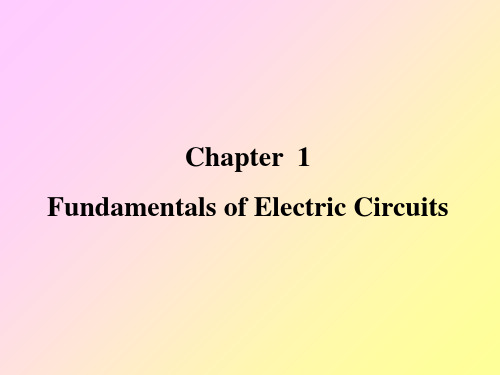
The voltage between node 1 and the reference node 3 is identified as u1, and u2 is defined between node 2 and the reference. These two voltages are sufficient, and the voltage between any other pair of nodes may be found in terms of them. For example, the voltage of node 1 with respect to node 2 is (u1– u2).
0 .5 u 1 0 .2 (u 1 u 2) 3
or
0.7u10.2u23
At node 2 we obtain
u20.2(u2u1)2
or
0.2u11.2u22
(1-19) (1-20)
Section5 Basic Analysis Methods
Solve the Eq.(1-19) and Eq. (1-20) to obtain the unknown node voltage u1 and u2, then any current or power in the circuit may now be found. Steps to nodal analysis: (1)Select a node as the reference node. Assign voltages u1 , u2 , …,un–1 to the remaining n–1 node. (2)Apply KCL to each of the n–1 non-reference nodes. Use Ohm's law to express the branch currents in terms of node voltages.
(完整版)电气工程及其自动化专业英语第一章课文翻译
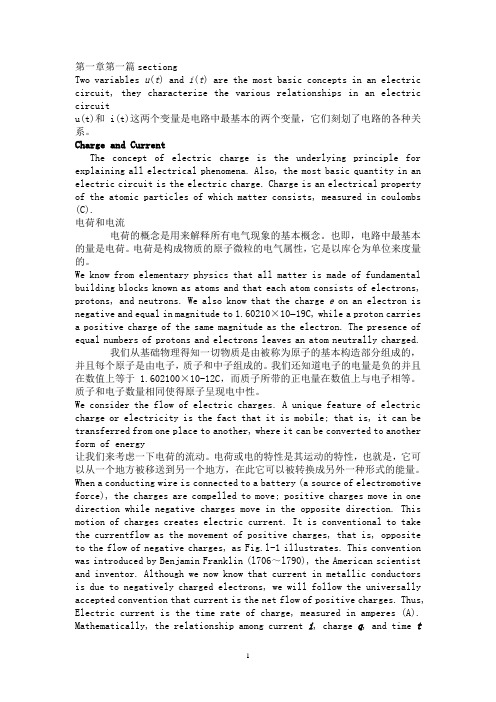
第一章第一篇sectiongTwo variables u(t) and i(t) are the most basic concepts in an electric circuit, they characterize the various relationships in an electric circuitu(t)和i(t)这两个变量是电路中最基本的两个变量,它们刻划了电路的各种关系。
Charge and CurrentThe concept of electric charge is the underlying principle for explaining all electrical phenomena. Also, the most basic quantity in an electric circuit is the electric charge. Charge is an electrical property of the atomic particles of which matter consists, measured in coulombs (C).电荷和电流电荷的概念是用来解释所有电气现象的基本概念。
也即,电路中最基本的量是电荷。
电荷是构成物质的原子微粒的电气属性,它是以库仑为单位来度量的。
We know from elementary physics that all matter is made of fundamental building blocks known as atoms and that each atom consists of electrons, protons, and neutrons. We also know that the charge e on an electron is negative and equal in magnitude to 1.60210×10 19C, while a proton carries a positive charge of the same magnitude as the electron. The presence of equal numbers of protons and electrons leaves an atom neutrally charged.我们从基础物理得知一切物质是由被称为原子的基本构造部分组成的,并且每个原子是由电子,质子和中子组成的。
电气工程及其自动化专业英语 Chapter 1 Fundamentals of Electric Circuits
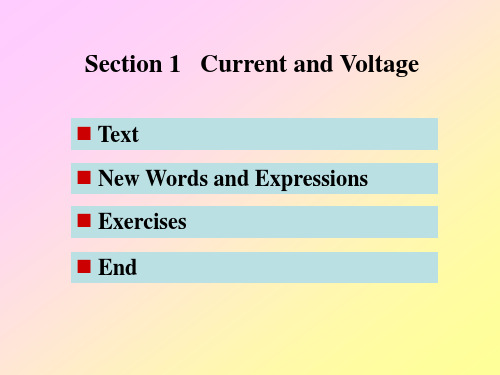
Section1 Current and Voltage
on the other hand, the power has a minus sign, power is being supplied by the element. But how do we know when the power has a negative or a positive sign? Current direction and voltage polarity play a major role in determining the sign of power. It is therefore important that we pay attention to the relationship between current i and voltage u in Fig.1-3(a).
Section1 Current and Voltage
Voltage, Energy, and Power
To move the electron in a conductor in a particular direction requires some work or energy transfer. This work is performed by an external electromotive force (emf), typically represented by the battery in Fig.l-1. This emf is also known as voltage or potential difference. The voltage uab between two points a and b in an electric circuit is the energy (or work) needed to move a unit charge from a to b; mathematically
- 1、下载文档前请自行甄别文档内容的完整性,平台不提供额外的编辑、内容补充、找答案等附加服务。
- 2、"仅部分预览"的文档,不可在线预览部分如存在完整性等问题,可反馈申请退款(可完整预览的文档不适用该条件!)。
- 3、如文档侵犯您的权益,请联系客服反馈,我们会尽快为您处理(人工客服工作时间:9:00-18:30)。
Section1 Current and Voltage
flow as the movement of positive charges, that is, opposite to the flow of negative charges, as Fig.l-1 illustrates. This convention was introduced by Benjamin Franklin (l706 ~ l790), the American scientist and inventor. Although we now know that current in metallic conductors is due to negatively charged electrons, we will follow the universally accepted convention that current is the net flow of positive charges. Thus, Electric current is the time rate of charge, measured in amperes (A). Mathematically, the relationship among current i, charge q, and time t is
Section1 Current and Voltage
i
The charge transferred between time t0 and t is obtained by integrating both sides of Eq. (1-1). We obtain t
dq dt
(1-1)
q idt
Section 1 Current and Voltage
Text
New Words and Expressions
Exercises
End
Section1 Current and Voltage
Two variables u(t) and i(t) are the most basic concepts in an electric circuit, they characterize the various relationships in an electric circuit. Charge and Current The concept of electric charge is the underlying principle for explaining all electrical phenomena. Also, the most basic quantity in an electric circuit is the electric charge. Charge is an electrical property of the atomic particles of which matter consists, measured in coulombs (C).
Section1 Current and Voltage
We consider the flow of electric charges. A unique feature of electric charge or electricity is the fact that it is mobile; that is, it can be transferred from one place to another, where it can be converted to another form of energy. When a conducting wire is connected to a battery (a source of electromotive force), the charges are compelled to move; positive charges move in one direction while negative charges move in the opposite direction. This motion of charges creates electric current. It is conventional to take the current
t0
(1-2)
The way we define current as i in Eq. (1-l) suggests that current need not be a constant-valued function, charge can vary with time in several ways that may be represented by different kinds of mathematical functions.
Section1 Current and Voltage
We know from elementary physics that all matter is made of fundamental building blocks known as atoms and that each atom consists of electrons, protons, and neutrons. We also know that the charge e on an electron is negative and equal in magnitude to 1.60210×1019C, while a proton carries a positive charge of the same magnitude as the electron. The presence of equal numbers of protons and electrons leaves an atom neutrally charged.
